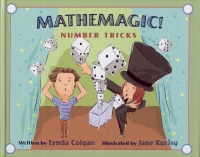| ________________
CM . . .
. Volume XVII Number 32. . . .April 22, 2011 
 |
Mathemagic! Number Tricks.
Lynda Colgan. Illustrated by Jane Kurisu.
Toronto, ON: Kids Can Press, 2011.
40 pp., hardcover, $17.95.
ISBN 978-1-55453-425-8.
Subject Heading:
Mathematical recreations-Juvenile literature
Grades 4-8 / Ages 9-13.
Review by Thomas Falkenberg.
**** /4
|
| |
|

excerpt:
If you're like most people, you've probably never used a bone to multiply, and you've probably never used X-ray vision to see through dice. Because if you're like most people, you didn't know you could – until now.
Mathemagic! Number Tricks is a book that gives the reader exactly what its title promises, namely a collection of tricks with numbers that, if executed properly, must seem to the general audience like magic – whether it is finding the sum of the hidden numbers on a dice, identifying a secret number chosen by the audience, or other forms of magical surprises. The book contains 12 major number tricks and very well designed, age-appropriate explanations of how each of the tricks works. In addition, the book contains some variations for some of the number tricks as well as very readable expansions on the mathematical ideas underlying some of the tricks. A one-page glossary of mathematical terminology used in the explanations completes the book.
Mathemagic! Number Tricks is very well-suited for different educational purposes in a school context, be it as a book in the school library or a resource book for teachers to engage their students in the magical sides of mathematical ideas.
Most of the number tricks presented in the book are based on quite sophisticated mathematical ideas involving numbers. This has two desired effects. First, it makes it difficult for the audience to see the magician "into the cards," so to speak, which keeps the tricks "magic." Second, for those students (and teachers) who want to get into understanding the tricks and their underlying mathematical ideas, the explanations of the tricks will most likely develop a deeper number sense in them than they had before. The excellent explanations of the tricks and their underlying mathematical ideas have a very high educational value. To be accurate, the explanations use the relevant mathematical terminology, like "the first digit in the product" and "multiples of 9," which are, however, explicated in the glossary at the end of the book.
But even for want-to-be magicians (students or teachers) who are not interested in how the tricks work or who find the underlying mathematics of some of the tricks to difficult to (yet) understand, the book should be of great value because the steps the magician needs to take to execute each of the tricks are very clearly outlined in a step-by-step fashion. A magician can be magical even if s/he does not know why a trick works! And for aspiring mathemagicians the book provides a number of helpful hints on how to perform the magic tricks well.
Fortunately, it is only the magician's outfit that is stereotypical in the illustrations that accompany each of the tricks: the middle-school-aged mathemagician wears a tuxedo and top hat, but is female, has long red hair, and performs in front of her peers that represent a range of ethnic backgrounds. Overall, I find the book to be an outstanding example of a book on "mathemagic," useful to middle-school students to study on their own and to teachers to use with their students as part of their regular or not-so-regular programs of mathematics teaching.
Highly Recommended.
Thomas Falkenberg is a teacher educator, specializing in mathematics education, in the Faculty of Education at the University of Manitoba.

To comment
on this title or this review, send mail to cm@umanitoba.ca.
Copyright © the Manitoba Library Association. Reproduction for personal
use is permitted only if this copyright notice is maintained. Any
other reproduction is prohibited without permission.
NEXT REVIEW |
TABLE OF CONTENTS FOR THIS ISSUE
- April 22, 2011.
AUTHORS |
TITLES |
MEDIA REVIEWS |
PROFILES |
BACK ISSUES |
SEARCH |
CMARCHIVE |
HOME |
